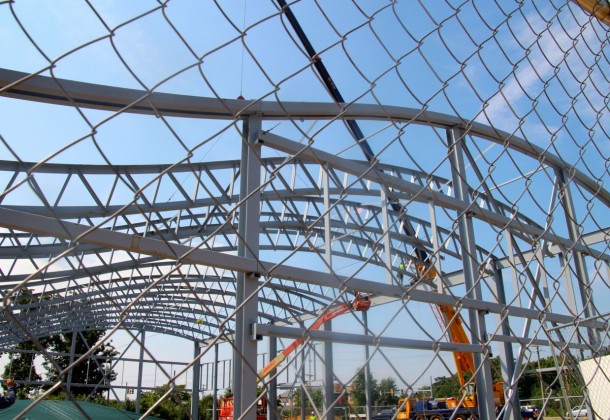Topping off Pax River Naval Air Museum

This week the final steel beam was fitted into place, topping the structure of the Pax River Naval Air Museum as it finally makes its mark upon the Lexington Park, MD landscape. The soaring steelwork is new and startling coming upon it from Pegg Road. And it is beautiful.
There’s been nothing simple or easy about building the Patuxent River Naval Air Museum. But no obstacle stopped a relentless pursuit to tell the history of naval aviation and explain its place into the future in a world-class museum at the gates to the Naval Air Station Patuxent River.
Some of the dozens of men and women who have worked to make the museum a reality were on hand Monday morning as the final truss was put into place. Each of the roof beams in the steel-framed building weighs 12,500 pounds. The steel was all manufactured in Maryland, fabricated and delivered in the span of weeks. The frame has gone up quickly as well.
Coming around the final bend in Pegg Road in Lexington Park, MD, heading toward Route 235 the structure rises above the tree line and appears to fly into the sky. Here its final truss is put into place.
Congressman Steny Hoyer, Delegate John Bohanan, and County Commission President Jack Russell spoke at the topping, introduced and thanked by the master of ceremony, Joe Dunn of the Patuxent River Naval Air Museum Association. The officials acknowledged the long road to accomplishing the goal and thanked the dedication of the many volunteers, businesses and agencies that contributed to the success.
The new museum will ultimately comprise 21,000 square feet and will cost about $5 million.
Federal funding provided $3.4 million for the project. Funding and support is also being provided through state and county sources.
Already begun is the upgrading of existing exhibits and well underway the planning for exhibits to be housed in the new facility. The New Pax Museum will use up-to-date presentation technology and interactive exhibits to explain the roles research, development, and testing played in the evolution of U.S. Naval Aviation.





















